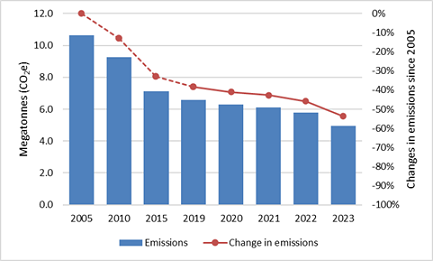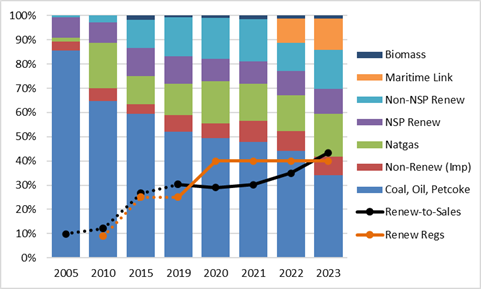Nova Scotia Power's past, present, and future emissions
Larry Hughes, PhD
Published AllNovaScotia.com 30 April 2024
What a difference two decades makes.
Between 2005 and 2023, Nova Scotia Power reduced its greenhouse emissions by almost 52%.
As the following figure shows, in 2005, NSP's emissions were about 10.65 megatonnes of greenhouse gases or CO2e. By 2023, emissions had declined by 5.7 megatonnes to about 4.93 megatonnes.

Nova Scotia Power's emissions between 2005 and 2023
NSP's reduction in emissions was made possible by significant changes to the way it produces electricity and a 10% decline in provincial electricity demand largely due to industrial closures.
Nova Scotia Power's energy mix
The combination of energy sources used by NSP, its energy mix, have become increasingly less emissions intensive since 2005. We see this in the next figure.
In 2005, almost 86% of NSP's electricity came from the combustion of coal, oil, and petcoke (or petroleum coke). By 2010, this had fallen to 65% because of the increased use of natural gas.
The province's Renewable Electricity Regulations (Renew Regs in the figure), which came into force in 2010, required the percentage of renewable sources of the electricity sold to its customers to increase from 14% of sales in 2012 to 25% in 2015 through 2019. From 2020 through 2029, the percentage is set at 40%.
Between 2015 and 2019, wind-generated electricity from sources in Nova Scotia other than NSP (Non-NSP Renew in the figure) was meeting between 11% and 17% of the province's electricity demand. When combined with NSP's renewables (NSP Renew in the figure), the 25% target was met.
When the Renewable Electricity Regulations were developed, it had been assumed that by 2020, NSP would have access to the 824-megawatt Muskrat Falls hydroelectric site in Labrador. This was to supply NSP with about 1,130 gigawatt-hours of electricity from the Muskrat Falls via the Labrador-Island Link (LIL) and the Maritime Link starting in 2020. In 2025, this was to have been reduced to 890 gigawatt-hours.
However, lengthy construction delays, significant cost overruns, repeated software faults, and extreme weather events meant that Newfoundland and Labrador Hydro, responsible for Muskrat Falls and LIL, was unable to transmit electricity in 2020. The volumes transmitted in 2021 were miniscule.
Things changed in 2022 when the Maritime Link started transmitting significant quantities of electricity over the Maritime Link from Muskrat Falls and other sources. The commissioning of LIL in early 2023 resulted in Newfoundland and Labrador Hydro transmitting about 1,970 gigawatt-hours over the Maritime Link in 2023.

Nova Scotia Power's energy mix for 2005 through 2023
The combination of electricity from Muskrat Falls, renewables from NSP and sources other than NSP, natural gas, and biomass were responsible for reducing NSP's to 4.93 megatonnes emissions in 2023.
What's next?
The province has set NSP three emissions-related targets for 2030.
First, NSP is to phase out its use of coal; second, to have a renewables-to-sales ratio of 80%; and third, to reduce its emissions to less than 4.5 megatonnes.
Achieving the third target is essential if Nova Scotia is to reduce its emissions by at least 53% below 2005 levels by 2030.
According to NSP's Integrated Resource Plan (IRP), in 2030, coal will have been phased out and wind will meet about half of the province's electricity demand (about three times more than it did in 2023). In addition, the IRP projects NSP's emissions to be between half-a-megatonne and 1.4 megatonnes in 2030, well under the province's emissions limit.
The challenge will be whether Nova Scotians will tolerate the installation of more onshore wind turbines in the province, not only from NSP, but also from two hydrogen developers.
This might explain why the province's latest attempt at reforming the electricity sector allows NSP to "construct a generating plant that utilizes nuclear energy to produce electricity".